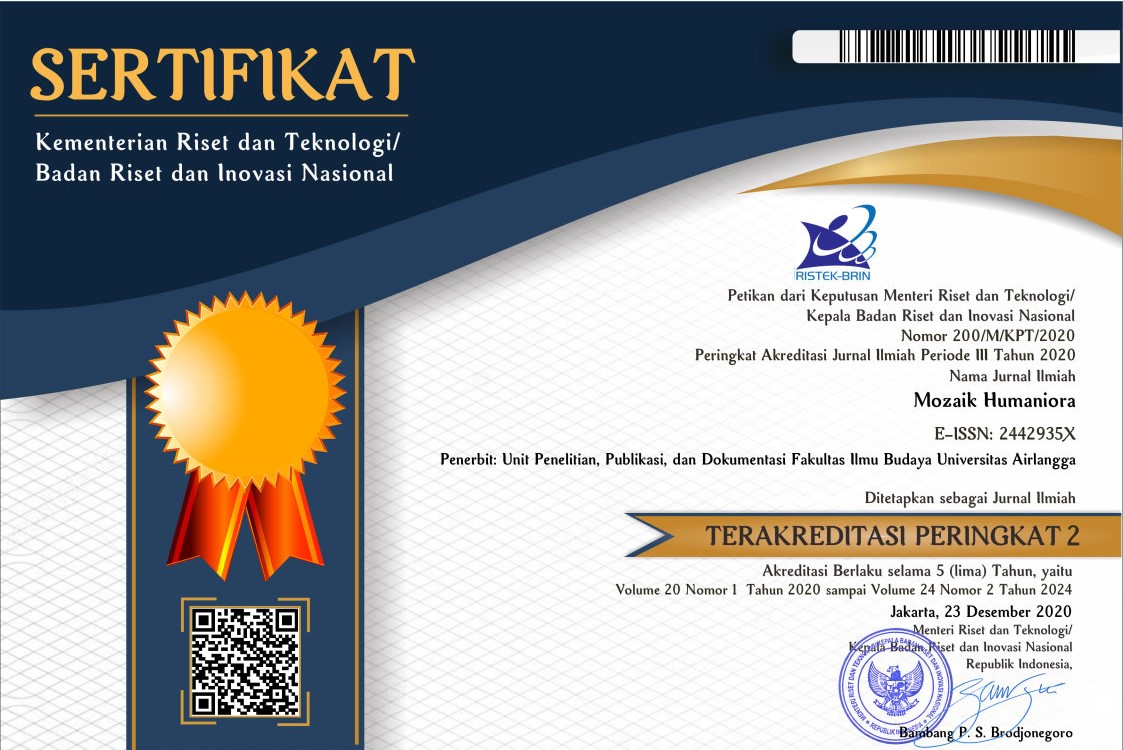Ekspresi Semantis Verba dan Pelibatan Argumen dalam Klausa Bahasa Bima
Downloads
Bimanese language is an Austronesian, Malayo Polinesian Language (Arafik 2005). In 1986, Jonker conducted a research on this language. His reseach focused on sintactic structure of the language. Jonker's analisis (1896) looked similar with Owens' analisis (2000) that stated there are two common features of the Bimanese as one of the Austronesian language, they are affixing and compounding. With the base features, Owens considered that Bimanese at least has one of the features or even both features as well. His work focused on verb expression and bound arguments in Bimanese clauses. The two problems were analyzed based on Functional Lexical Grammar theory proposed by Kroeger (2005). The theory contains three sintactic aspects, such as functional structure, constituent structure, and argument structure. Data were collected through elicitation and observation method. Elicitation was applied to obtain spoken data while observation method was used to collect written data from texts. Both methods were supported by note taking technique and recording. The collected data were analyzed by substitution and immediate constituent technique. The result shows that Bimanese verbs can express their arguments syntactically by using verb semantic meaning and preposition like labo, kai, wea, and ba-. It was also found that the obligatory arguments in a clause are generally marked with the four markers.
Arafiq. 2005. "Relasi Gramatikal Konstruksi Kausatif dan Aplikatif Bahasa Bima” (tesis). Denpasar. Universitas Udayana.
Arka, I Wayan.2000. "Control and Argument Structure : Explaning Control Into Subject in Indonesia”. 4th International Symposium on Malay/Indonesian Linguistics, Jakarta, 26 July 2000.
Bungin, Burhan. 2003. Analisis Data Penelitian Kualitatif. Jakarta: PT Raja Grafindo Persada.
Halliday, Michael A.K. 1967. "Notes on Transitivity anf Theme in English”. Part 1. Journal of Linguistics.
Jonker, J.C.G. 1896. Bimaneesche Spraakkunsj. Uitgegeven door.
Kroger, Paul L. 2004. Analyzing Syntax: A Lexical--Functional Approach. Cambridge: Cambridge University Press.
Kroeger, Paul L.2005. Analyzing Grammar. Cambridge: Cambridge University Press.
Lyons, John. 1995. Pengantar Teori Linguistik. (Soetikno. Pentj). Jakarta: PT Gramedia Pustaka Utama.
Mithun, Marrianne. 2001. "Who shapes the record: the speaker and the linguist”. In Newman, Paul and Martha Ratliff, editors. Linguistics Fieldwork. First Edition. Cambridge: Cambrigde University Press.
Owens, Melanie.2000. "Agreement in Bimanese” (Tesis). University of Canterbury.
Satyawati,Made Sri. 2009. "Valency and Syntactical Relation in Bimanese. E-Journal of Linguistics 3(2): 1”9.
Sudaryanto, 1986. Metode Linguistik. Ke Arah Memahami Metode Linguistik: Yogyakarta: Gadjah Mada University Press.
Sudaryanto. 1993. Metode Linguistik: Ke Arah Memahami Metode Linguistik. Yogyakarta: Gadjah Mada University Press.
Van Valin Robert D., Jr. and William A. Foley, 1980. Role and Reference Grammar dalam Moravcsik and Wirth, editors.
Van Valin, Robert D.,Jr dan Randy J. la Polla. 1997. Syntax: Structure, Meaning, and Function. Cambridge: Cambridge University Press.
Van Valin, Robert D., Jr. 2005. Exploring the Syntax-Semantics Interface. First Edition. Cambrige: Cambrigde University Press.

Mozaik Humaniora is licensed under a Creative Commons Attribution-ShareAlike 4.0 International License. Both authors and Mozaik Humaniora agree with the following attribution of journal:
1. Copyright of this journal is possession of Author, by the knowledge of the Editorial Board and Journal Manager, while the moral right of the publication belongs to the author.
2. The journal allows the author(s) to retain publishing rights without restrictions
3. The legal formal aspect of journal publication accessibility refers to Creative Commons Attribution Share-Alike (CC BY-SA).
4. The Creative Commons Attribution Share-Alike (CC BY-SA) license allows re-distribution and re-use of a licensed work on the conditions that the creator is appropriately credited and that any derivative work is made available under "the same, similar or a compatible license”. Other than the conditions mentioned above, the editorial board is not responsible for copyright violation.


















